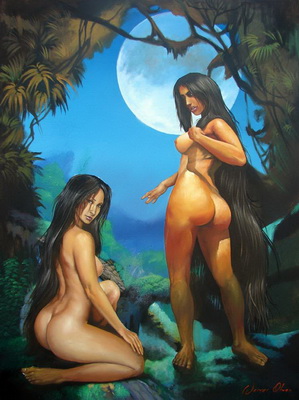The
Ciguapa is a mythological creature of Dominican folklore. Ciguapas are
commonly described as having human female form with brown or dark blue skin,
backward facing feet, and very long manes of smooth, glossy hair that covers
their otherwise naked bodies. They supposedly inhabit the high mountains of
the Dominican Republic.
These
creatures have nocturnal habits. Also, due to the position of their feet,
one can never quite tell from which direction the beings are moving from by
looking at their footprints. Some people believe that they bring death, and
it is said that one should not look them in the eye, otherwise the person is
at risk of being bewitched permanently. Also, the only vocalization made by
Ciguapas is said to be a kind of whine or chirping.
Ciguapas
are considered to be magical beings, beautiful in appearance to some, yet
horrendous to others. All sources agree that they are wild creatures. They
are compared in many cases to mermaids: beautiful yet cruel, and far from
innocent. Deceitful and ready to capture the wayward traveler, it is said
that they are so beautiful as to lure men into the forest, even though
following footprints is misleading, to have sex with them only to kill them
afterwards. Even today, one can still find inhabitants who confirm having
sighted a Ciguapa.

Lore
states that the only way to capture a Ciguapa is by tracking them at night,
during a full moon, with a black and white polydactylic dog (called cinqueño
dog).
Though
many believe that the myth of the Ciguapa is of Taino origin, it has been
argued that is probably of more recent concoction, being possibly attributed
to African beliefs brought to the island by slaves during the colonial
period. More to the point, no known Taino artifacts or lore make reference
to any creature even remotely similar to it. Also, the legend may have
originated from other myths, as distant as the Guaraní Curupí or the Hindu
Churel, which was described by Rudyard Kipling in My Own True Ghost Story as
having traits amazingly similar to those of the Ciguapa. Nonetheless, the
Hindu hypothesis may be far-fetched since there is no way to ascertain how
this story got to the Dominican Republic during the nineteenth century, when
no cultural exchange whatsoever occurred between these nations.